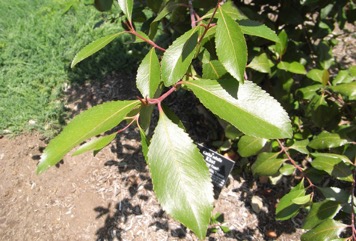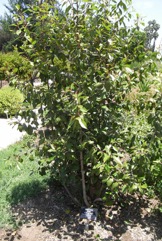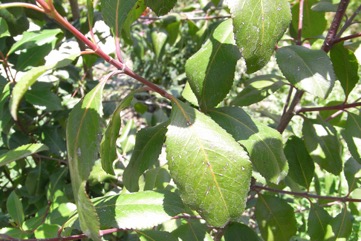Arabian tea tree, Bushman’s tea, Khat

A tropical plant. It does best on well drained soils. It prefers an open sunny position. It is drought and frost tender. In Uganda they grow from 1,400-2,200 m altitude. In Ethiopia it grows between 900-2,400 m above sea level. It needs a temperature above 10°C. It grows in areas with a rainfall between 800-1,800 mm per year. It suits hardiness zones 10-12. In XTBG Yunnan.
Also known as:
Abyssinian tea, Boesmanstee, Cat, Igqwaka, Iwani, Kat, Luthadzi, Mkalanga, Mlomomnandzi, Muhulo, Mushyuluti, Mutsawari, Muza-ramashawa, Ndimamadzi, Qaad, Quat, Umhlwazi, Umlomo-mnandzi
Synonyms
- Catha forsskalii A. Rich.
- Catha inermis J. F. Gmel.
- Celastrus edulis Vahl
- Dillonia abyssinica Sacleux
- Methyscophyllum glaucum Eckl. & Zeyh.
Edible Portion
- Leaves - tea, Caution, Fruit
Where does Arabian tea tree grow?
Found in: Africa, Australia, Angola, Asia, Central Africa, China, Congo, East Africa, Eswatini, Ethiopia, Hawaii, India, Israel, Kenya, Madagascar, Malawi, Mozambique, Saudi Arabia, Somalia, South Africa, Southern Africa, Swaziland, Tanzania, Uganda, United States, Yemen, Zambia, Zimbabwe
Notes: There is only one Catha species. The leaves contain the alkaloids cathine, cathenine and cathidine. They affect the nervous system. The plant is banned in some countries.
Status: It's use is common in Somalia and Yemen.
Growing Arabian tea tree, Bushman’s tea, Khat
Cultivation: Plants can be grown from seed or by using cuttings. Suckers and root cuttings can be used. Seeds germinate within 2 weeks. (There are 60,000-80,000 seeds per kg.) Plants can be shaped or pruned.
Edible Uses: The leaves are chewed as a stimulant. They can also be made into a tea. They are dried for tea. Caution: There are cautions about the excessive chewing of leaves. It can cause impotence.
Production: The tree is fast growing. It suckers readily. The stimulant effect is less in cooler places.
Nutrition Info
per 100g edible portion| Edible Part | Energy (kcal) | Protein (g) | Iron (mg) | Vitamin A (ug) | Vitamin c (mg) | Zinc (mg) | % Water |
|---|---|---|---|---|---|---|---|
| Leaves - tea | - | - | - | - | - | - |
Arabian tea tree, Bushman’s tea, Khat Photos



References
Ambasta S.P. (Ed.), 2000, The Useful Plants of India. CSIR India. p 111
Bekele-Tesemma A., Birnie, A., & Tengnas, B., 1993, Useful Trees and Shrubs for Ethiopia. Regional Soil Conservation Unit. Technical Handbook No 5. p 142
Ben-Shabat, S., et al, 2014, Farming Amphetamines: Khat (Catha edulis Forsk.) a Traditional Plant with Mild Stimulating Psychoactive and Medicinal Properties, in Z. Yaniv, N. Dudai (eds.), Medicinal and Aromatic Plants of the Middle-East, Springer
Bodkin, F., 1991, Encyclopedia Botanica. Cornstalk publishing, p 228
Brouk, B., 1975, Plants Consumed by Man. Academic Press, London. p 350
Brown, D., 2002, The Royal Horticultural Society encyclopedia of Herbs and their uses. DK Books. p 158
Cundall, P., (ed.), 2004, Gardening Australia: flora: the gardener's bible. ABC Books. p 342
Dale, I. R. and Greenway, P. J., 1961, Kenya Trees and Shrubs. Nairobi. p 134
Ench. bot. 575. 1841
Etherington, K., & Imwold, D., (Eds), 2001, Botanica's Trees & Shrubs. The illustrated A-Z of over 8500 trees and shrubs. Random House, Australia. p 191
Facciola, S., 1998, Cornucopia 2: a Source Book of Edible Plants. Kampong Publications, p 75
Fowler, D. G., 2007, Zambian Plants: Their Vernacular Names and Uses. Kew. p 17
Fox, F. W. & Young, M. E. N., 1982, Food from the Veld. Delta Books. p 149
Goode, P., 1989, Edible Plants of Uganda. FAO p 30
Gouldstone, S., 1983, Growing your own Food-bearing Plants in Australia. Macmillan p 163
Hedrick, U.P., 1919, (Ed.), Sturtevant's edible plants of the world. p 176
Heywood, V.H., Brummitt, R.K., Culham, A., and Seberg, O. 2007, Flowering Plant Families of the World. Royal Botanical Gardens, Kew. p 94
Hibbert, M., 2002, The Aussie Plant Finder 2002, Florilegium. p 62
Katende, A.B., Birnie, A & Tengnas B., 1995, Useful Trees and Shrubs for Uganda. Identification, Propagation and Management for Agricultural and Pastoral Communities. Technical handbook No 10. Regional Soil Conservation Unit, Nairobi, Kenya. p 166
Long, C., 2005, Swaziland's Flora - siSwati names and Uses http://www.sntc.org.sz/flora/
Lord, E.E., & Willis, J.H., 1999, Shrubs and Trees for Australian gardens. Lothian. p 212
Lovett, J. C. et al, Field Guide to the Moist Forest Trees of Tanzania. p 35
Magwede, K., van Wyk, B.-E., & van Wyk, A. E., 2019, An inventory of Vhavenḓa useful plants. South African Journal of Botany 122 (2019) 57–89
Martin, F.W. & Ruberte, R.M., 1979, Edible Leaves of the Tropics. Antillian College Press, Mayaguez, Puerto Rico. p 106
Maundu, P. et al, 1999, Traditional Food Plants of Kenya. National Museum of Kenya. 288p
Mbuya, L.P., Msanga, H.P., Ruffo, C.K., Birnie, A & Tengnas, B., 1994, Useful Trees and Shrubs for Tanzania. Regional Soil Conservation Unit. Technical Handbook No 6. p 172
Molla, A., Ethiopian Plant Names. http://www.ethiopic.com/aplants.htm
Ojelel, S., et al, 2019, Wild edible plants used by communities in and around selected forest reserves of Teso-Karamoja region, Uganda. Journal of Ethnobiology and Ethnomedicine (2019) 15:3
Palgrave, K.C., 1996, Trees of Southern Africa. Struik Publishers. p 505
Palmer, E and Pitman, N., 1972, Trees of Southern Africa. Vol. 2. A.A. Balkema, Cape Town p 1300
Plowes, N. J. & Taylor, F. W., 1997, The Processing of Indigenous Fruits and other Wildfoods of Southern Africa. in Smartt, L. & Haq. (Eds) Domestication, Production and Utilization of New Crops. ICUC p 187
Purseglove, J.W., 1968, Tropical Crops Dicotyledons, Longmans. p 630
Recher, P, 2001, Fruit Spirit Botanical Gardens Plant Index. www.nrg.com.au/~recher/ seedlist.html p 5
Ruiters-Welcome, A. K., 2019, Food plants of southern Africa. Ph.D. thesis. Univ. of Johannesburg p 42
Schmidt, E., Lotter, M., & McCleland, W., 2007, Trees and shrubs of Mpumalanga and Kruger National Park. Jacana Media p 332
Swaziland's Flora Database http://www.sntc.org.sz/flora
Tredgold, M.H., 1986, Food Plants of Zimbabwe. Mambo Press. p 94
van Wyk, B, van Wyk, P, and van Wyk B., 2000, Photographic guide to Trees of Southern Africa. Briza. p 82
Venter, F & J., 2009, Making the most of Indigenous Trees. Briza. p 96
Vickery, M.L. and Vickery, B., 1979, Plant Products of Tropical Africa, Macmillan. p 90
White, F., Dowsett-Lemaire, F. and Chapman, J. D., 2001, Evergreen Forest Flora of Malawi. Kew. p 185
Williamson, J., 2005, Useful Plants of Malawi. 3rd. Edition. Mdadzi Book Trust. p 59
World Checklist of Useful Plant Species 2020. Royal Botanic Gardens, Kew